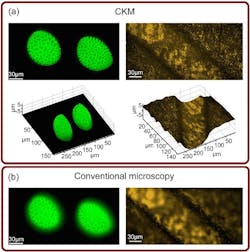CKM computational imaging improves microscopy depth of field 10-fold
In typical microscopy approaches, a 'Z-stack' of up to 100 images are recorded and combined computationally into a single sharp image with an extended depth of field (DOF). Other more sophisticated techniques have been developed for high-resolution 3D microscopy, such as light-sheet fluorescence microscopy, confocal/multiphoton microscopy, and localization super-resolution microscopy (although the latter two are not strictly 3D techniques in themselves). Due to their scanning nature, however, none of these techniques can be used for snapshot or video-rate imaging.
Researchers at the University of Glasgow (Glasgow, Scotland) have developed a new approach, called complementary kernel matching (CKM) that can be used to extend the DOF by a factor of 10 in a single snapshot, thus enabling its use for time-resolved or video-rate microscopy. Furthermore, 3D ranging of the sample is achieved simultaneously in the technique.
RELATED ARTICLE: Super-resolution microscopy of large fields in living cells possible with sCMOS
CKM--a computational imaging technique--involves optical encoding of the captured image, as well as digital decoding that is used to reconstruct a sharp output image. To achieve optical encoding, the researchers use a phase plate at the aperture of the microscope objective and capture two distinct images with complementary information. In one such implementation of CKM, a microscope is equipped with the CKM-encoding element (a phase plate) and a CKM-splitting element (consisting of a beam splitter, and mirrors to replicate the desired image) that separates the two encoded images onto a single camera to realize snapshot operation.
SOURCE: SPIE Newsroom; http://spie.org/newsroom/6749-computational-imaging-for-3d-micrographs-with-10-fold-depth-of-field-enhancement?highlight=x2416

Gail Overton | Senior Editor (2004-2020)
Gail has more than 30 years of engineering, marketing, product management, and editorial experience in the photonics and optical communications industry. Before joining the staff at Laser Focus World in 2004, she held many product management and product marketing roles in the fiber-optics industry, most notably at Hughes (El Segundo, CA), GTE Labs (Waltham, MA), Corning (Corning, NY), Photon Kinetics (Beaverton, OR), and Newport Corporation (Irvine, CA). During her marketing career, Gail published articles in WDM Solutions and Sensors magazine and traveled internationally to conduct product and sales training. Gail received her BS degree in physics, with an emphasis in optics, from San Diego State University in San Diego, CA in May 1986.
